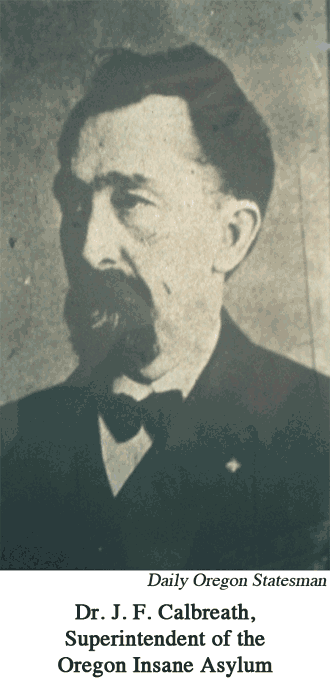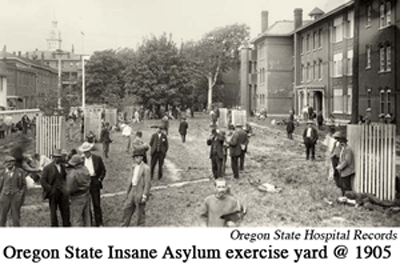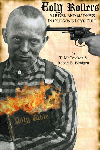Daily Oregon Statesman January 1, 1907
INSANE ASYLUM
________
WHERE HUNDREDS OF UNFORTUNATE PEOPLE ARE CARED FOR BY THE STATE
________
Numerous Substantial Buildings Located on a Sightly Place in the Eastern Portion of Oregon's Capital City--A Large Institution--Many Inmates.
________
 Just
within the eastern borders of the city of Salem lies a group
of brick buildings that loom up on an eminence there in
picturesque grandeur, and the stranger is at once attracted
by their comeliness and asks why and for what they are
there.
Just
within the eastern borders of the city of Salem lies a group
of brick buildings that loom up on an eminence there in
picturesque grandeur, and the stranger is at once attracted
by their comeliness and asks why and for what they are
there.
Beautiful for situation is the Oregon State Insane Asylum with its view of the city and surrounding country, its massive yet graceful brick buildings set in grounds that are kept attractive at all seasons of year, its gardens laid out in a splendid manned and its numerous detached buildings in harmony with the main structure.
When the state of Oregon chose the site, it was a wise choice. Close enough to the city to bring its army of employees within touch of social attractions of the city, yet far enough removed (at present at least) to give perfect freedom from annoyance to the inmates who are able to take exercise in the open air, it lies high enough above the fogs of the lower ground to escape them and low enough to give easy access by foot, team, or electric railway to the grounds.
The asylum is a place that has many visitors, both relatives of those confined within its walls and those who are interested in visiting the state institution during a visit to Salem. Visitors are admitted each day from 10 to 12 in the morning and from 2 to 4 in the afternoon, excepting on Saturdays and Sundays. On entering the reception hallway, a guide is ready to make the rounds of the wards, explaining to the visitor the different classes of patients, their manner of segregation, and the methods the attendants use in handling them. A trip through the wards requires almost an hour, if any care at all is taken to study the institution, and the most rapid walking will hardly accomplish the task in less than thirty minutes, so extensive are the hallways and corridors. A visitor is generally shown first through the male wards, and then through the female wards, taking in turn the violent, the imbecile, the milder cases, and the children, and then is taken through the various shops, the kitchen, laundry, etc. Throughout them all the visitor will notice the great care that the employees exercise over the patients in their charge, amusing them when necessary, helping them if need be, and restraining them wisely when they become excited.
What struck the writer most forcibly during the visit was the affection which seemed to exist in the patient for the attendant, and in no place was there found any harshness or undue severity. The patients were cleanly, and while they were not clothed in fine material, were all comfortable and so far as their condition would allow were in good spirits.
 It
is one of the most difficult things in the world for a
person in possession of all his faculties to minister day
after day to the mind diseased without many things that
annoy, much that will try the patience, and much that would
call for severity. And yet, Dr. Calbreath in his choice of
assistants has gathered together a body of employees whose
one aim seems to be the care of those over whom they
exercise restraint, and whose most cheerful devotion to duty
is to be commended.
It
is one of the most difficult things in the world for a
person in possession of all his faculties to minister day
after day to the mind diseased without many things that
annoy, much that will try the patience, and much that would
call for severity. And yet, Dr. Calbreath in his choice of
assistants has gathered together a body of employees whose
one aim seems to be the care of those over whom they
exercise restraint, and whose most cheerful devotion to duty
is to be commended.
The buildings are arranged with special
idea of adaptability to the purpose for which they are used.
Each of the wards is connected with a sun parlor, where on
winter days when the inmates cannot go out of doors, they
can gather for a time and enjoy the brightness of the open
without being subject to the atmospheric conditions existing
outside the walls of the building. The bedrooms of the
patients open off the corridors, as do those of the
attendants and various subordinate officers. This enables
the attendants to be in close touch with their patients both
day and night, and is a wise precaution against possible
trouble between patients should one become suddenly violent
or manage to escape from his room in the night. Some of the
rooms are provided with two beds, some with three, care
being taken that only the milder patients are allowed room
mates. The rooms are heated by steam, the radiators being so
arranged that one will heat two rooms. In the more violent
wards, the radiators are protected by a heavy iron netting
to prevent the patients from injuring themselves. The night
watchmen have a full view of each bedroom from the corridors
without the necessity of opening the doors.
The floors of the building are of hard wood, polished to a high degree by years of constant oiling and cleaning which is carried on day after day to keep the patients employed. In female wards strips of matting or carpet run down the center of the corridors, this concession being made to the finer tastes of the female patients.
To describe the Oregon State Insane
Asylum so as to convey a clear conception of its magnitude
is a difficult thing to do. But when one states that it
requires 182 employees to handle the patients; that its
furnaces, ranges and bake ovens consume 600 cords of wood
each month; its patients eat 1,000 loaves of bread each day;
and that it shelters nearly 2,000 persons; then it will
convey a slight conception to the reader of the extensive
business the care of the state insane involves, and the
ability required in its superintendent and his assistants to
have everything run smoothly , with economy to the taxpayer,
and with the best results to the patients under
treatment.
In feeding the patients, each ward is given a separate dining room, to which the food is brought from the general kitchen. The inmates of the ward are watched carefully while at meals and the food served is both nourishing and wholesome, and is well cooked. Much credit is due the cooks and bakers for the efficient way in which they prepare the supplies for their many borders, and to the excellent system by which the entire number of inmates is fed in a very short time.
The grounds of the asylum are kept in shape by the inmates, it being a pleasure for the more robust of them to do light garden work, and there are always plenty for the work. The shortage of labor so much felt everywhere else is not appreciated here. The difficulty is to find the work that will keep the minds of the patients able to work from brooding.
In addition to the buildings at Salem, the asylum has a farm about six miles southeast of the city where a number of inmates are kept under the cottage system, and where the vegetables used in the asylum are largely raised. This farm is under the management of an overseer and a physician is stationed there.
It is always interesting to know those who are in charge of the different departments in the state's works, and we include in this article a complete list of those connected with the asylum on December 1, the last date for which the list was available when this article was written: (To see the list of employees)
Chapter 9 of Holy Rollers: Murder & Madness in Oregon's Love Cult
(The Holy Rollers are Committed to the Insane Asylum)
Copies of Some of the Holy Rollers' Commitment Papers to the Oregon Insane Asylum
The Oregon Insane Asylum in 1907
From my Blog: My Day at The Oregon Insane Asylum
A Bit of History about Oregon's Asylums and Their Patients
An Excerpt from Diane L. Goeres-Gardner’s book
Murder, Morality and Madness: Women Criminals in Early Oregon
Newspaper Articles from 1904 about the Holy Rollers being Committed to the Insane Asylum
New York Times Article: "Once a ‘Cuckoo’s Nest,’ Now a Museum"
Steilacoom Insane Asylum
(Where Esther Mitchell Was committed in 1907)
Chapters from
Holy Rollers: Murder & Madness in Oregon's Love Cult
Part 1: The Seduction
Chapter 1: Trust Me, Brothers And Sisters
(Life Before Creffield [B.C.])
Chapter 2: God, Save Us From Compromising Preachers
(Creffield's Preachings)
Chapter 3: The Flock
(Profiles of the Holy Rollers Were)
Chapter 4: The Holy Rollers
(Things Start to Get Wild on on Kiger Island)
Chapter 5: Housecleaning
(There's a Sacrificial Bonfire)
Chapter 6: Community Concerns
(Officers Visit)
Chapter 7: Esther, The Chosen One
(Creffield Plans to Marry 16-Year- Old)
Chapter 8: Tar and Feathers
(The Men of Corvallis Act)
Chapter 9: Sane People Don’t Go Bareheaded
(Holy Rollers are Committed to the Asylum)
Chapter 10: More Beast Than Man
( Creffield is Arrested)
Chapter 11: God Will Plead Creffield's Case
(Creffield in Court)
Chapter 12: Scandal
(Shocking Testimony at the Trial)
Chapter 13: Calm Before the Storm
(The Holy Rollers Resume their Lives)
Chapter 14: Giving Up The Ghost
(Men are Gunning for Creffield)
Part Two: The People V. Creffield
Chapter 16: The Widow Creffield
Chapter 19: An Inherited Streak of Insanity
Part Three: The Madness
Chapter 23: Seeking Reconciliation
Chapter 24: Another Holy Roller Page One Murder
Chapter 25: What Can Papa Do For You?
Chapter 26: Human Life is Too Cheap In This Community
Chapter 30: The Final Chapter
(What Happened to Everyone Afterwards)
The Epilogue
(Heaven's Gate)
Information about Brainwashing & Thought Reform
Lifton's eight 'psychological themes' that can be found in totalist groups like the Holy Rollers:
***
Stanley Milgram's Obedience to Authority
***
Think You Can't be Lured into a Cult? Think Again.
The Oregon State Insane Asylum in 1907
***
Relevant Newspaper Articles:
October to December 1903: Holy Rollers Burn Furniture & Pets
April to June 1904: Holy Rollers are Committed to the Asylum
